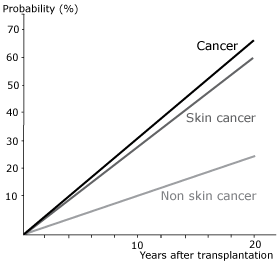Tumors after organ transplantationImmunosuppressive medications used to control rejection increase the incidence of typically two types of tumors: Skin cancerCarcinomas (squamous-cell skin cancer) account for the majority of tumors after solid organ transplantation (65-250 fold higher for a person receiving a transplant than for a healthy patient; time of appearance is 7-8 years; 50 to 70% of the subject develop carcinoma after 20 years). Incidence of carcinomas are mainly related to sun exposure, that can be explained by a diminished capacity to repaired UV-induced mutations under immunosuppressive state. Infections by papilloma virus of the oncogen types may also by a source of carcinoma. Kaposi disease is induced by an herpes virus. It Constitutes 4% of cancers in transplanted patients (0,05% in healthy population).
LymphomasThe risk of lymphoma during the first post transplant year is 20 and 120 fold higher after kidney or heart transplantation, respectively, than that in the general population. Risks strongly influenced by the type of organ transplanted (heart-lung show the higher risk) Lymphomas affect up to 5 % of all transplant recipient. Most cases of post transplant lymphoma have been linked to unrestrained proliferation of Epstein-Barr virus-infected B-cells caused by suppression of normal immunosurveillance mechanisms by immunotherapy. Lymphoma are generally detected first year post transplant. The risk posed by specific immunosuppressive agents is controversial. The intensity of immunosuppression, rather than any individual agents, is the key determinant in lymphoma formation. Age has an incidence in lymphoma formation in kidney recipients with higher rates in children < 10 year-old and in adults > 60 years. |
|
|
Transplantation Immunology | |||||||||||||||||||
|
||||||||||||||||||||



 Print
Print